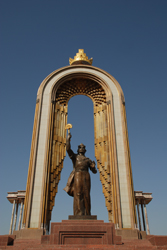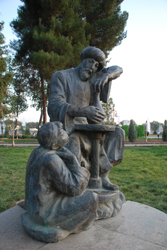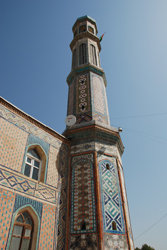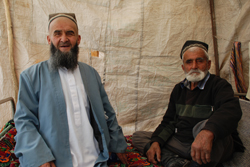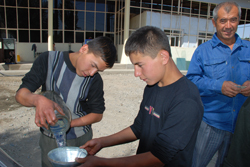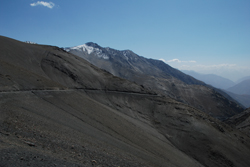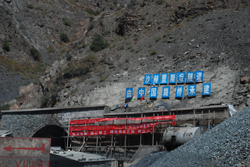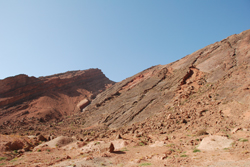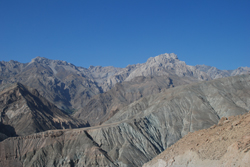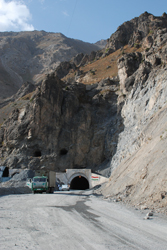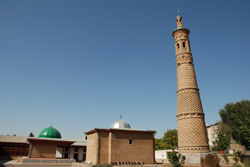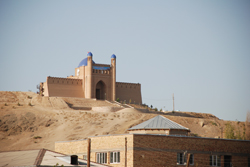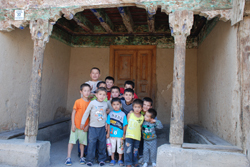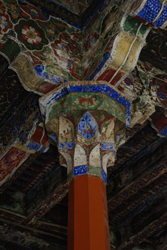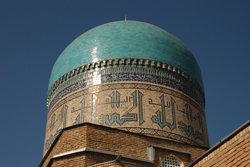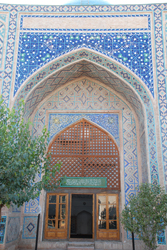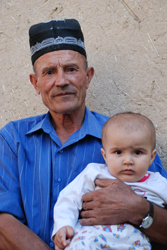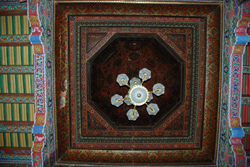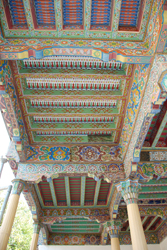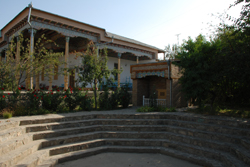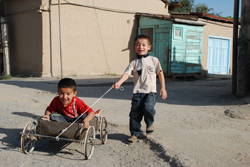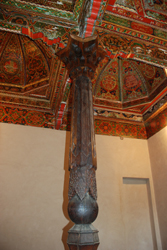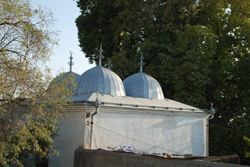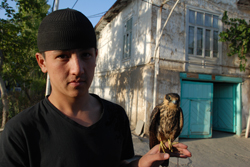Dushanbe: Tajik Independence Day
9 September, 2008, 11:19 am in "Tajikistan"
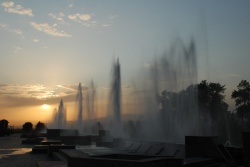 Dushanbe is a clean city with big colonial neo-classical buildings and big trees. The main drag is named after the poet Rudaki. Off Rudaki, the streets seem to contain mostly a combination of residential or government buildings. Dushanbe is known for being nice but not the most interesting place in the world. As in many of the other cities we've been to in Central Asia, it serves the long term traveler as a good place to use the Internet and find a decent cup of coffee.
Dushanbe is a clean city with big colonial neo-classical buildings and big trees. The main drag is named after the poet Rudaki. Off Rudaki, the streets seem to contain mostly a combination of residential or government buildings. Dushanbe is known for being nice but not the most interesting place in the world. As in many of the other cities we've been to in Central Asia, it serves the long term traveler as a good place to use the Internet and find a decent cup of coffee. Today was Independence Day. We didn't see any official celebrations. However, there were lots of people out enjoying the holiday. The main gathering place seemed to be the Bagh-i-Rudaki, the central park which I believe has been newly re-designed and/or expanded. There are lots of benches with little garbage cans next to them (a rarity in Central Asia), paths, new grass, and trees smaller than other trees around the city. There are several sculptures including one of a potter. People looked dressed up, though it is hard to tell because perhaps they always dress that way.
We walked up Rudaki and caught sight of a minaret. It was part of the fairly modern-looking Haji Yakoub Mosque and Medressa. A man sitting outside was astonished when Rowshan said he was from Iran saying, “With your long hair, I thought you were a Westerner”. Rowshan held his tongue and didn't respond, “Your prophets had long hair,” as he wanted to. There were some beautifully carved doors and I wondered where we could find the workshops where they are made. As we walked around the outside of the mosque, Rowshan noticed a satellite TV dish mounted on the minaret.
We've been trying to get an idea of people's opinion of life after independence. While at a seamstress shop, once again trying to fix Rowshan's pants, Rowshan chatted with the women there who were working on Tajik dresses of satins and velvets with ornate yokes. When he asked if things were better now or during the Soviet Union, one said, "Before, one person's salary could feed 8 people. Now you can barely feed just yourself."
Istaravshan to Dushanbe: Construction, Crashes, and 3 Mountain Ranges
8 September, 2008, 10:19 am in "Tajikistan"
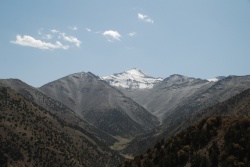 While waiting for additional people to share a taxi to Dushanbe, we had nothing to do but sit and people watch. Rowshan went to chat with a couple melon sellers resting in the shade.
While waiting for additional people to share a taxi to Dushanbe, we had nothing to do but sit and people watch. Rowshan went to chat with a couple melon sellers resting in the shade.We ended up paying for an extra seat so it came to $50 total. The first driver tried to charge $200. He pissed me off and kept insisting that no one would take us for as cheap as we wanted. "The tunnel is flooded! with water up to here!" he said gesturing to show hip level. Finally he went away and we found a different taxi.
After a gas stop where the gas pumps didn't work so a couple guys just ran out and mixed the gasoline as they poured it into the tank, we hit the road.
After a gas stop where the gas pumps didn't work so a couple guys just ran out and mixed the gasoline as they poured it into the tank, we hit the road.
It was newly paved thanks to Chinese road crews. We passed a quarry where workers were making mud bricks. The hill was dug into and piles of bricks stood in front.
Suddenly the road ahead was closed by nothing more than a man holding a wire with a few colored flags across it. Road construction. Worst of all, there was no detour, so we had to turn around and go back the way we came searching for something to use as a detour. 4WD vehicles drove off the road making their own detours. A Shahristan minibus went a little farther back up the road and turned off onto a dirt track. Our driver reconfirmed that it eventually joined the main road, then followed. The dirt track led around some corn fields and through a fallow field, then joined what seemed like a real gravel road which led through a river bed and alongside a village of adobe houses. Eventually a road led off of it ending at the paved road, past the road work. The driver exclaimed, "These Chinese road crews drive us crazy. They close off the road but never make detour routes!" However, the road construction was a good thing and it was a pleasure to smoothly coast on new asphalt. Chinese construction crews were also putting up brand new electrical towers which shone bright silver and white, though still wireless. Rowshan remarked that it looked like the president was doing a lot to improve the country. The driver agreed saying most people were happy with what the president was doing. In fact, the president would be visiting Istaravshan today to open a new Obi Zuld plant-- an Italian/Tajik joint venture bottled spring water company .
As we got closer to the mountains, the driver suddenly stopped the car and ran across the street, dodging oncoming trucks to give alms to a man in a wheel chair who would pray for his safety on the road. He ran back and we headed into the mountains. The hills became taller and their surface, leathery with splotches of trees-- maybe juniper.
We passed a landing pad where the president's helicopter would be arriving. A worker was sweeping it off. Around this point, the new road ended and we started up a dirt and gravel road which showed some signs of having been paved at one point-- maybe when it was part of the Soviet Union. We began winding up this road higher into the mountains. As we approached the Shahristan pass (3378m).
Suddenly the road ahead was closed by nothing more than a man holding a wire with a few colored flags across it. Road construction. Worst of all, there was no detour, so we had to turn around and go back the way we came searching for something to use as a detour. 4WD vehicles drove off the road making their own detours. A Shahristan minibus went a little farther back up the road and turned off onto a dirt track. Our driver reconfirmed that it eventually joined the main road, then followed. The dirt track led around some corn fields and through a fallow field, then joined what seemed like a real gravel road which led through a river bed and alongside a village of adobe houses. Eventually a road led off of it ending at the paved road, past the road work. The driver exclaimed, "These Chinese road crews drive us crazy. They close off the road but never make detour routes!" However, the road construction was a good thing and it was a pleasure to smoothly coast on new asphalt. Chinese construction crews were also putting up brand new electrical towers which shone bright silver and white, though still wireless. Rowshan remarked that it looked like the president was doing a lot to improve the country. The driver agreed saying most people were happy with what the president was doing. In fact, the president would be visiting Istaravshan today to open a new Obi Zuld plant-- an Italian/Tajik joint venture bottled spring water company .
As we got closer to the mountains, the driver suddenly stopped the car and ran across the street, dodging oncoming trucks to give alms to a man in a wheel chair who would pray for his safety on the road. He ran back and we headed into the mountains. The hills became taller and their surface, leathery with splotches of trees-- maybe juniper.
We passed a landing pad where the president's helicopter would be arriving. A worker was sweeping it off. Around this point, the new road ended and we started up a dirt and gravel road which showed some signs of having been paved at one point-- maybe when it was part of the Soviet Union. We began winding up this road higher into the mountains. As we approached the Shahristan pass (3378m).
The brownish tan of the surrounding mountains shifted to dark gray. They looked like giant piles of ashes. Some had a light dusting of snow. Beyond the pass were layers of mountains after mountains. We'd reached the summit of the Turkestan ridge but there were still the Fan Mountains and Zerafshan Mountains to get through. While high in the mountains, Rowshan looked down into the valley and saw the remains of about 6 cars which had gone off the road and plummeted down the mountains side.
We headed down the other side, a rough queasy road. At the base was the site of a tunnel marked with Chinese writing and flags. It was under construction but would some day save drivers the long climb and descent.
We headed down the other side, a rough queasy road. At the base was the site of a tunnel marked with Chinese writing and flags. It was under construction but would some day save drivers the long climb and descent.
The road was easier, running along the valley but very dusty. Up ahead we saw a huge cloud of dust and quickly rolled up our windows. Then we saw a crumpled truck off the side of the road. Its load of carrots and potatoes filling the ground in front of it. Our driver stopped the car and ran over. I heard him saying something and pulling a blanket out of the crushed cab of the truck. I called Rowshan over. “There is someone in there!” Rowshan came running and brought water. He splashed it on the guy but there was no response. The driver had called up the road to some men and now a crowd gathered. Rowshan and the driver said the man was probably already dead. We left and the driver informed the police at the next checkpoint so they could inform the driver's family. He returned disgusted, and said the police didn't care and weren't doing anything because they were only interested in stopping people to get bribes.
We passed several road crews and Chinese worker camps. Then we were dismayed to come up against a truck stopped by a wire with flags across the road. The road crew wouldn't let us through. They let several other cars, driven by Chinese workers, through however. The driver argued with the guy working who said we could go through at 6:30PM. It was 3:00.
After about ½ hour, the controller let us go through. There was nothing going on and we saw no point for the road block. 5 minutes later, we came to another road block. The controller angrily pointed at our driver and signaled him to go back. Our driver yelled in Russian and Tajik and the controller yelled in Chinese, since neither of them spoke the other's language. On the other side was a bunch of waiting cars and trucks, with angry drivers. One pointed to a picture of Chinese and Tajik flags on his vehicle and tried to express brotherly feeling, putting his arm around the controller. Another tried to bribe the controller who threw the money on the ground. When the controller walked down the street a ways, the driver who had tried to bribe him lowered the wire and let us speed through. There was nothing blocking the road and we cruised on angry at the controller.... until we came to another barrier. Ahead we could see rocks being knocked from the hill above into the street. The 3 guys in charge of that post seemed more laid back than the other workers. I guess they didn't have to deal with communicating since the reason for their block was obvious. While we were waiting we saw a white helicopter fly over us. The driver said it was the president and we all watched it. Then 2 of the workers lowered the wire and ran to clear the rocks from the road. It was around 4-- much better than 6:00-7 as had been predicted. We scooted through and followed the road which had become paved again and led along a river. There were some impressive red hills where rocks looked folded into layers. Beyond were mountains of various shades of browns, reds, and beiges. We passed through a very pleasant region of tree-shaded river and a village with stone houses built into the hill above the river bank. I thought what a pleasant vacation spot it would be if getting there was easier.
We passed several road crews and Chinese worker camps. Then we were dismayed to come up against a truck stopped by a wire with flags across the road. The road crew wouldn't let us through. They let several other cars, driven by Chinese workers, through however. The driver argued with the guy working who said we could go through at 6:30PM. It was 3:00.
After about ½ hour, the controller let us go through. There was nothing going on and we saw no point for the road block. 5 minutes later, we came to another road block. The controller angrily pointed at our driver and signaled him to go back. Our driver yelled in Russian and Tajik and the controller yelled in Chinese, since neither of them spoke the other's language. On the other side was a bunch of waiting cars and trucks, with angry drivers. One pointed to a picture of Chinese and Tajik flags on his vehicle and tried to express brotherly feeling, putting his arm around the controller. Another tried to bribe the controller who threw the money on the ground. When the controller walked down the street a ways, the driver who had tried to bribe him lowered the wire and let us speed through. There was nothing blocking the road and we cruised on angry at the controller.... until we came to another barrier. Ahead we could see rocks being knocked from the hill above into the street. The 3 guys in charge of that post seemed more laid back than the other workers. I guess they didn't have to deal with communicating since the reason for their block was obvious. While we were waiting we saw a white helicopter fly over us. The driver said it was the president and we all watched it. Then 2 of the workers lowered the wire and ran to clear the rocks from the road. It was around 4-- much better than 6:00-7 as had been predicted. We scooted through and followed the road which had become paved again and led along a river. There were some impressive red hills where rocks looked folded into layers. Beyond were mountains of various shades of browns, reds, and beiges. We passed through a very pleasant region of tree-shaded river and a village with stone houses built into the hill above the river bank. I thought what a pleasant vacation spot it would be if getting there was easier.
Once again the road got rough as we hit more construction and a mine or factory. We climbed into the mountains again and at last reached the Iranian tunnel. The entrance was full of construction machines and materials.
There were two sides. One was blocked by a pool of water. I began to wonder if there was some truth to what the taxi driver who had wanted $200 said. We entered the other side and found lots of water but not a meter deep as I'd been told. The tunnel was long, dark and damp. As we drove, with water splashing in waves beside us, I thought how if they added some pirates in the caves on the sides (leading to the other tunnel) it would be like Disney's Pirates of the Caribbean except you'd go through the water in a car instead of boat. There were some rough looking worker guys but they weren't in pirate costume. The other side of the tunnel was also under construction.
Beyond the tunnel were more construction crews. By this time we were all really tired of construction crews and gravel roads. We finally got beyond them and out of the mountains where the road was flat and smoothly ran to Dushanbe. When we told people about the trip, many said, “You should have gone at night. That is what most people do.” However, navigating those roads in the dark, sounded a lot worse than waiting for construction crews to let us through.
Beyond the tunnel were more construction crews. By this time we were all really tired of construction crews and gravel roads. We finally got beyond them and out of the mountains where the road was flat and smoothly ran to Dushanbe. When we told people about the trip, many said, “You should have gone at night. That is what most people do.” However, navigating those roads in the dark, sounded a lot worse than waiting for construction crews to let us through.
Istaravshan: The US and Iran Are at War
7 September, 2008, 10:19 am in "Tajikistan"
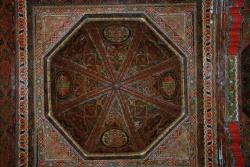 On our way to Istaravshan we passed a lot of cotton fields. However, one of the passengers said the cotton crop hadn't been good for the past couple years because there hadn't been enough rain. Beyond the fields were dry hills. In some barren fields, dust devils spun.
On our way to Istaravshan we passed a lot of cotton fields. However, one of the passengers said the cotton crop hadn't been good for the past couple years because there hadn't been enough rain. Beyond the fields were dry hills. In some barren fields, dust devils spun.We were surprised by the quality of the road. It turned out to be built by China. The driver said the roads built by the Tajiks just got destroyed quickly. Istaravshan did not look too exciting. It had the standard types of Soviet buildings, a busy bazaar with lots of brick structures and lots of taxi drivers trying to get us to go to Dushanbe, Khojand, or anywhere else but where we were.
The hotel we stayed in hadn't been cleaned in recent history but we were relieved to not see roaches. I found a cigarette box which had been used as an ash tray along with a bag of trash on a shelf under the TV. Rowshan found a jar with maybe some slices of moldy bread. We wiped crumbs off the table, picked up gum and cigarette butts off the floor and decided if these 2 hotels we've stayed at in Tajikistan are any sign of what to expect, we need to invest in cleaning supplies and bug killer. I was distressed to find a flea while sitting on the bed.
When we asked the hotel manager if he had some bug killer spray, he said not to worry, the fleas would be asleep at night and wouldn't bother us. We asked for a light bulb because the bulb in the toilet room was out. He responded that the light in the room outside of it worked so we could just leave the door open.
We decided to find the old town which was supposed to be one of the best preserved in Tajikistan. We walked up Lenina and found the Hazret-i-Shah Mosque and mausoleum. It seemed fairly modern though built in a traditional style with a pretty brick minaret.
Next to it was a park with lots of flowers surrounding a statue of Rudaki. Behind were reliefs of famous Tajiks. I think they were all writers since each had a quill underneath their head and poetry above them. From here we had a view of Mug Tepe, which had once been the site of an ancient fortress, but now was just a mud hill with a reconstructed gate.
We took a road into the old town which, although many buildings were built with traditional adobe, looked in good condition and had evidently been repaired. Some had been covered with concrete. At one point we noticed a niche in the wall where kids were playing. There were wooden columns and ceiling as well as some interesting but very worn ceiling paintings.
A man nearby said it was called the Burchak Mosque and would we like to see it. He led us in and showed us an outside area protected by a fabric curtain where there were beautiful wood paintings in need of restoration. Inside the mosque were more. The colors were rich and the paintings ornate tezhip designs.
We walked up the street and came to the Abdullatif Sultan Medressa. This had a turquoise dome, which gave it the nickname Kok Gumbaz, and lots of brick and tile work a little reminiscent of Turkistan.
In the courtyard were roses. Two kids on bikes joined us. They studied in the medressa and thought it neat that Rowshan knew Persian since they were learning to read the Arabic alphabet.
They also thought it strange an American and Iranian were married since "The US and Iran are at war." "What?! Iran and the US aren't at war!" we replied. The kids insisted they were. Rowshan and I hadn't seen the news for a couple days so we wondered if we'd missed some important news. Then Rowshan said, with all the people we'd been talking to, someone would have mentioned if there was a war. (Instead the only news item anyone mentioned to me was snow along the equator).
Outside the gate we passed some locals sitting outside of their house, and acquired a group of kids who accompanied us to the Hauz-i-Sangin mosque which also had beautiful ceiling paintings.
They also thought it strange an American and Iranian were married since "The US and Iran are at war." "What?! Iran and the US aren't at war!" we replied. The kids insisted they were. Rowshan and I hadn't seen the news for a couple days so we wondered if we'd missed some important news. Then Rowshan said, with all the people we'd been talking to, someone would have mentioned if there was a war. (Instead the only news item anyone mentioned to me was snow along the equator).
Outside the gate we passed some locals sitting outside of their house, and acquired a group of kids who accompanied us to the Hauz-i-Sangin mosque which also had beautiful ceiling paintings.
Most had been restored though I'm a little dubious about the restoration since the colors all seemed so much lighter and the tezhip seemed to have been done with wider strokes. There were 2 sections that were still fully original and these were amazing-- deep rich colors and fine detailed lines. Maybe the deepness of the color was from age or dirt, but I liked the dark colors better than the light ones. Outside there was a stone pool which was dry but was surrounded by roses.
We left the group of kids we'd acquired behind but did met two more kids who had a great little cart made from an old suitcase.
To find the Mazar-i-Chor Gumbaz (the tomb of 4 domes) we walked back through the old town. From the exterior, it was an unassuming building but inside, the painted ceilings were magnificent with each dome decorated differently. Walking back to the center we saw a guy with a falcon perched on his finger.
To find the Mazar-i-Chor Gumbaz (the tomb of 4 domes) we walked back through the old town. From the exterior, it was an unassuming building but inside, the painted ceilings were magnificent with each dome decorated differently. Walking back to the center we saw a guy with a falcon perched on his finger.
More kids begged for photos and we met a guy on a bicycle who also said Iran and the US were at war.
We walked into the center and, on a local's recommendation, we tried a new restaurant for dinner. The restaurant was clean! The table had been wiped. The food came quickly and was good and a guy working there (maybe the owner) was sociable and sat and talked a bit, happy to find out Rowshan was Iranian.
Tajiks are very fond of Ahmedinajad but not specifically because he is against America. In Tajikistan they see Ahmedinajad as a humanitarian helping the country. Iran builds roads, works on civil engineering projects and most recently completed a tunnel through the Anzob pass cutting what used to be a 10 hour trip from Istaravshan to Dushanbe to 7 or 8. We'll see tomorrow.
We walked into the center and, on a local's recommendation, we tried a new restaurant for dinner. The restaurant was clean! The table had been wiped. The food came quickly and was good and a guy working there (maybe the owner) was sociable and sat and talked a bit, happy to find out Rowshan was Iranian.
Tajiks are very fond of Ahmedinajad but not specifically because he is against America. In Tajikistan they see Ahmedinajad as a humanitarian helping the country. Iran builds roads, works on civil engineering projects and most recently completed a tunnel through the Anzob pass cutting what used to be a 10 hour trip from Istaravshan to Dushanbe to 7 or 8. We'll see tomorrow.


